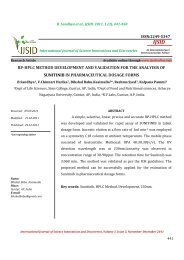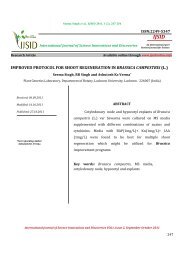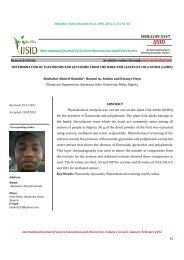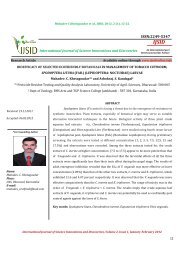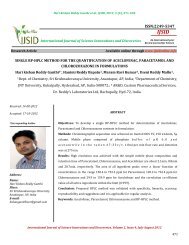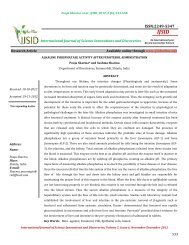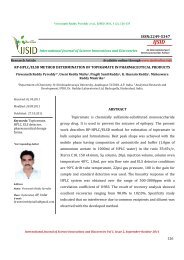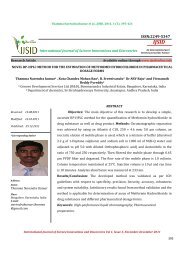PREPARATION OF INJERA FROM PRE ... - Ijsidonline.info
PREPARATION OF INJERA FROM PRE ... - Ijsidonline.info
PREPARATION OF INJERA FROM PRE ... - Ijsidonline.info
Create successful ePaper yourself
Turn your PDF publications into a flip-book with our unique Google optimized e-Paper software.
Hiwot Tadesse Abiyu et al., IJSID, 2013, 3 (1), 165-175<br />
ISSN:2249-5347<br />
IJSID<br />
International Journal of Science Innovations and Discoveries<br />
An International peer<br />
Review Journal for Science<br />
Research Article<br />
Available online through www.ijsidonline.<strong>info</strong><br />
<strong><strong>PRE</strong>PARATION</strong> <strong>OF</strong> <strong>INJERA</strong> <strong>FROM</strong> <strong>PRE</strong>-FERMENTED FLOUR: NUTRITIONAL AND SENSORY QUALITY<br />
Hiwot Tadesse Abiyu 1 , Ashagrie ZewduWoldegiorgis 1 , Gulelat Desse Haki 2 *<br />
1 Addis Ababa University, College of Natural Science, Addis Ababa, Ethiopia, 2* Botswana College of Agriculture, Private Bag<br />
0027, Gaborone, Botswana.<br />
Received: 15-01-2013<br />
Accepted: 18-02-2013<br />
*Corresponding Author<br />
ABSTRACT<br />
The study investigated the possibility of using prefermented instant flour for the<br />
production of injera (pancake -like, soft, sour, circular flatbread and a staple food for<br />
majority of Ethiopians) by using different drying methods. The effects of drying methods<br />
used were compared with the traditional method in chemical composition and sensory<br />
properties of the products. The result in sensory analysis gave overall acceptability scores<br />
as 5.74, 6.22 and 7.68 for sun dried, oven dried and freeze dried products, respectively.<br />
The moisture content was 53.57, 53.83 and 56.4 g/100g for oven dried, sun dried and<br />
freeze dried products, respectively. The respective values of the proximate composition<br />
Address:<br />
Name:<br />
Gulelat Desse Haki<br />
Place:<br />
Botswana<br />
E-mail:<br />
hgulelat@bca.bw,<br />
gulelatw@yahoo.com<br />
for sun dried, freeze dried and oven dried products were 8.73, 9.05 and 10.03 protein,<br />
4.65, 3.53 and 4.65 (g/100g) ash, 2.75, 2.62 and 3.52 g/100g crude fat and 1.91, 2.23 and<br />
2.67g/100g crude fiber. The iron, calcium and phosphorus contents, respectively were<br />
INTRODUCTION<br />
12.12, 13.27, and 14.18 g/100g; 33.62, 33.65 and 34.95 and 507.85, 567.85 and<br />
659.80(g/100g). Phytate was 232.55, 248.9 and 264.97 for oven dried, sun dried and<br />
freeze dried samples, respectively. Phytate phosphorus content was 63.47, 79.92 and<br />
81.46mg/100g for oven dried sun dried and freeze dried samples, respectively. On the<br />
other hand, non phytate phosphorus content was 432.93, 499.15 and 596.33mg/100g for<br />
INTRODUCTION<br />
freeze dried, sun dried and oven dried samples, respectively. The results show that there<br />
is a possibility of industrializing injera preparation process using instant prefermented<br />
flour.<br />
Key words: Prefermented flour, freeze drying, oven drying, sun drying, injera<br />
International Journal of Science Innovations and Discoveries, Volume 3, Issue 1, January-February 2013<br />
165
Hiwot Tadesse Abiyu et al., IJSID, 2013, 3 (1), 165-175<br />
INTRODUCTION<br />
Injera is a staple food for majority of Ethiopians. It is a fermented, pancake-like, soft, sour, circular flatbread (1). It is<br />
made from flour, water and starter ‘ersho. ‘Ersho’ is a fluid saved from previously fermented dough. Injera can be produced<br />
from various cereals depending on availability and abundance of the cereals (2). It can be made from teff ( Eragrostis tef),<br />
wheat, barley, sorghum or maize or a combination of some of these cereals (3). Good injera is soft, fluffy and able to be rolled<br />
without cracking.. Teff (Eragrostis tef) injera is getting popularity in Ethiopia as well us in the developed world because of its<br />
gluten free nature and being a whole grain product (4). However, the longer fermentation time and the requirement of some<br />
skills make injera preparation usually difficult.<br />
Achi (5) stated that traditional fermented foods are usually made under primitive conditions, which result in low yield<br />
and inconsistent quality. In addition, to this, preparation of traditional fermented foods is time consuming. According to Nout<br />
(6) the art of traditional processes needs to be transformed into a technology to standardize quality of the end products<br />
without losing their desirable traits.<br />
Several innovations have been made to solve different problems of bakery products. For instance, prefermented<br />
frozen dough has been used to bake fermented products by the home users with short period of time by purchasing<br />
prefermented frozen dough (7). Another innovation was the use of prefermented flour in bakery industries (8). In this case,<br />
the flour is made after the fermented dough is dried and grounded into flour. The prefermented flour can then be used to make<br />
bakery products with no further fermentation by the user (8).<br />
Although injera is a staple food for majority of Ethiopians, its preparation takes several days as it involves longer<br />
fermentation process. According to Hamaker (9) as industrialization expand and civilization achieved, people will be busy and<br />
face time constraints to cook foods with longer process. Due to these reasons they prefer to use processed or semi processed<br />
foods from industries. These interests are started to be reflected in urban societies of Ethiopia. Some people are buying baked<br />
injera from shops rather than baking at home.<br />
The present study aimed at providing a method for producing prefermented flour which is easy to perform, timely<br />
and produces uniform results. Further, an attempt was done to optimize use of prefermented or sour flour and evaluate its<br />
effect on the sensory quality and chemical composition of injera.<br />
METHODOLOGY<br />
Study site<br />
The study was conducted at Addis Ababa University, College of Natural sciences at the Center for Food science and<br />
Nutrition. The teff variety (Quncho) used for analysis was brought from Debreziet Agricultural Research Center (DZARC),<br />
Ethiopia.<br />
Preparation of prefermented flour<br />
The teff sample brought from DZARC was manually cleaned, milled, sieved in a 0.425mm sieve and stored in<br />
polyethylene bag. Three hundred gram of flour and 600ml of water were mixed with 100ml of back sloped liquid starter<br />
culture. The back sloped starter culture used was prepared from the flour which was used for analysis to avoid contamination.<br />
The mixture was kneaded for five minutes. The dough was left to ferment for 48 hours. The yellowish liquid at the top of the<br />
dough was discarded after 48hrs fermentation (3) . After the liquid is discarded the dough was measured in a graduated<br />
cylinder and ¼ of it was boiled (locally known as “absit” (3). After the absit was cooled it was mixed with the rest of the dough.<br />
International Journal of Science Innovations and Discoveries, Volume 3, Issue 1, January-February 2013<br />
166
Hiwot Tadesse Abiyu et al., IJSID, 2013, 3 (1), 165-175<br />
Then it was left to ferment once again and it took 35min to rise. This dough which is ready to be baked in the regular process<br />
was taken into different dryers.<br />
Drying of pre-fermented flour<br />
1 Freeze drying<br />
The fermented dough prepared in the traditional process was poured in a round and flat bottom flasks and put in a<br />
deep freezer for 12hrs so that the liquid dough could solidify. The next day the frozen dough in the flasks were fixed in the<br />
freeze drier. The temperature used in the freeze drier was (-43 to -47˚C). The dried dough was milled again and seived with a<br />
0.425 mm seive.<br />
2 Oven drying<br />
The prefermented dough was poured in to metal plates and it was kept in a hot air drying oven with a temperature of<br />
60 ºC to avoid further fermentation (10). The dried dough was milled again and seived with a 0.425 mm seive.<br />
3 Sun drying<br />
For sun drying the dough was poured in flat bottomed containers and allowed to dry using sun. In order to prevent<br />
the dough from contaminants, it was covered with a thin cloth. The dried dough was milled again and seived with a 0.425 mm<br />
seive.<br />
Preparation of injera from pre-fermented flours<br />
All the dried products were milled by a laboratory mill and sieved with 0.425 mm sieve to get prefermented flour. After<br />
having the prefermented flour, different trials were made to get good quality injera.<br />
i. Pre-fermented flours were mixed with cold water and the mixture was left to undergo fermentation and baked after<br />
30 min proofing time.<br />
ii. Pre-fermented flours were mixed with hot water (45 0 C) to the flour used in the first procedure and left to ferment for<br />
30 min. and baked.<br />
iii. Pre-fermented flours were mixed with back sloped starter culture to the flour used in the first procedure and left to<br />
ferment for 30 min. and baked.<br />
iv. The fourth procedure was adding “Absit” to the prefermented flour and left to ferment for 30 min. and baked<br />
v. The last procedure was mixing prefermented flour with water and left for 20 min to rehydrate and baking powder<br />
(baking soda and phosphates of sodium) was added and stayed for 10 min and baked (total of 30 min.).<br />
In all cases dough mixtures were agitated by mixing to ensure that proper eyes are created (11). Prefermented flour<br />
prepared in all the three drying methods was used to go over the four trials. The samples used for sensory quality and<br />
chemical composition analysis were injera prepared from prefermented flour using baking powder.<br />
Evaluation sensory quality of injera prepared from pre-fermented flours<br />
Injera prepared from the different prefermented flours was evaluated for its sensory acceptability by using 50<br />
consumer panels. All the panelists were frequent consumers of injera. The age range of the panelists was 22-45, so that they<br />
could fill the score card properly. At the beginning of the taste panelists were instructed about the objective of the study and<br />
how they could fill the score card based on their evaluation. The panelists were asked to evaluate the different types of injera<br />
on the bases of appearance, color, taste, fluffiness, eye size and distribution and overall acceptability based on a nine point<br />
hedonic scale(1=dislike extremely, 5=neither like nor dislike, 9= like extremely).<br />
Evaluation nutritional quality of injera prepared from pre-fermented flours<br />
International Journal of Science Innovations and Discoveries, Volume 3, Issue 1, January-February 2013<br />
167
Hiwot Tadesse Abiyu et al., IJSID, 2013, 3 (1), 165-175<br />
1 PROXIMATE COMPOSITION<br />
All the analyses were conducted on a dry weight basis except moisture content which is evaluated in a wet bases.<br />
1.1 Determination of moisture content<br />
Moisture of the prefermented flours and injera prepared from prefermented flour were determined according to<br />
AOAC (12).<br />
1.2 Determination of crude protein<br />
The crude protein content of the samples was estimated by the Kjeldhal method (13), in which the samples were<br />
digested with a known quantity of concentrated sulphuric acid in the Kjeltec digestion apparatus. The digested material was<br />
distilled after the addition of alkali. The released ammonia was collected in 4% boric acid Kjeltec Automatic Distilling Unit. The<br />
resultant boric acid containing the ammonia released from the digested material was titrated against 0.1 N HCl. The nitrogen<br />
content was multiplied by a factor of 6.25 correlate with the amount of crude protein.<br />
1.3 Determination of ash<br />
Total ash content of injera samples was determined according to AOAC (13).<br />
1.4 Determination of crude fat<br />
The fat content of the samples were determined by Soxhlet, using diethyl ether as a solvent (13).<br />
1.5 Determination of crude fiber<br />
Crude fiber content of pre-fermented flour and injera samples was determined according to AOAC (12).<br />
1.6 Determination of utilisable carbohydrate<br />
Total carbohydrates were calculated by difference with the following formula:<br />
Total carbohydrates (g/100g dry weight) =100 - [g protein + g crude fat + g ash+ crude fiber]<br />
1.7 Determination of gross energy<br />
Total energy was calculated according to the following equations:<br />
Energy (kcal/100g) =4 x (g protein +g carbohydrate) +9 x (g lipid)<br />
2 DETERMINATION <strong>OF</strong> MINERALS<br />
All the analysis was conducted on a dry weight basis.<br />
2..1 Prevention of contamination<br />
To minimize the risk of contamination, glass wares were washed with 10 % HNO 3 acid and crucibles were soaked<br />
with 6N HCl for 24 hours after being washed with detergent and water. All materials were then rinsed with distilled-deionized<br />
water and dried in an oven before use.<br />
2. 2 Digestion of injera samples<br />
Digestion of injera samples was carried out by following the dry ashing method (14) and (15) with some<br />
modifications. 2.5 grams of sample was placed in a porcelain crucible and ashed in an oven at 450 0 C for 24 hr. Ashed material<br />
was dissolved in 2 ml of concentrated HNO 3, evaporated to dryness, heated again to 450 0 C for 4 hr. Samples then was<br />
dissolved in 2 ml of concentrated H 2SO 4, 2 ml concentrated HNO 3 and 2 ml of H 2O 2, and diluted with distilled-deionized water<br />
up to 100 ml after adding 1 % LaCl 3 (2 ml). A blank digest was carried out in the same way.<br />
International Journal of Science Innovations and Discoveries, Volume 3, Issue 1, January-February 2013<br />
168
Hiwot Tadesse Abiyu et al., IJSID, 2013, 3 (1), 165-175<br />
2..3 Analysis of minerals with AAS<br />
For the mineral analyses, PG-990 atomic absorption spectrometer (Beijing, China) was used by setting the<br />
appropriate wavelength for each metal. All metal ions (Fe and Ca) determination was carried out in an air/acetylene flame<br />
mode of the spectrophotometer. Phosphorus was determined using the molybdovanadate method (16).<br />
3 DETERMINATION <strong>OF</strong> ANTINUTRITIONAL FACTORS<br />
3.1 Determination of phytic acid<br />
The phytate content in the sample was determined according to the method described by Latta and Eskin (17), and<br />
later modified by Vaintraub and Lapteva (18). About 0.03 g of fresh samples was extracted with 10 ml 0.2N HCl in a<br />
mechanical shaker for 1 hour at a room temperature. The extract was centrifuged at 3000 rpm for 30 minute. The clear<br />
supernatant was used for phytate estimation. One ml of wade reagent (containing 0.03% solution of FeCl 3.6H 2O and 0.3% of<br />
sulfosalcilic acid in water) was added to 3 ml of the sample solution (supernatant) and the mixture was mixed on a vortex for 5<br />
seconds. Absorption readings at 500 nm were taken against a blank sample consisting of 3 ml extract solution with 2 ml of 0.2<br />
N HCl without wade reagent. Sodium salt of phytic acid (4.5 -30 mg/ml) was used as standard for construction of calibration<br />
curve (Absorbance = -0.004 phytic acid mg + 0.154, R 2 = 0.988).<br />
3.2 Phytate and non phytate phosphorous<br />
Phytate phosphorous was calculated by assuming phytate contains 28% phosphorus, i.e. [Phytate P = phytate * 0.28]<br />
and accordingly, non phytate phosphorous = total phosphorous - phytate phosphorous.<br />
STATISTICAL ANALYSIS<br />
Completely randomized design (CRD) was experimental design used for both the the sensory and nutritional analysis.<br />
One way ANOVA was used to compare the effect of processing method on proximate composition, antinutritional factor,<br />
mineral and sensory quality of injera prepared from prefermented flour. All the experimental results were means + standard<br />
deviation (SD) of three parallel measurements. Means were separated by LSD, using SPSS Version 15. All analysis was done at<br />
significance level of p
Hiwot Tadesse Abiyu et al., IJSID, 2013, 3 (1), 165-175<br />
yeasts. This trial was not also successful in our case since the prepared injera was poor (with very few or no eyes) (Fig. 8c).<br />
This might be due to the microbial cells are highly affected by the drying treatment. The other trial for the preparation of good<br />
quality injera from prefermented flour was addition of back sloped starter culture. This trial has resulted in a better injera<br />
(with few scattered eyes) compared to the other trials (Fig.2), but the quality of injera was not still satisfactory. The pre sence<br />
of eyes in this case might be due to the newly added yeasts from the back sloped starter.<br />
The last trial in the preparation of good quality injera from prefermented flour was addition of baking powder. This trial was<br />
successful since the quality of injera prepared was good (with enough number of eyes expected from good quality injera and<br />
with proper texture) (Fig.3). Bellido (19) stated that nature of chemical leavening systems makes them capable once<br />
incorporated into the dough by producing carbon dioxide in a typical processing or storage conditions such as at high<br />
temperatures, in microwave fields, and following prolonged refrigeration or frozen storage.<br />
a b c<br />
Figure 1. Injera prepared from prefermented flour + cold water Figure(a), prefermented<br />
flour + hot water(b) and Injera prepared flour mixed with water and Absit (c)<br />
Figure 2. Injera prepared from prefermented flour mixed with water and back sloped starter culture<br />
Figure 3 Injera prepared from prefermented flour, water and baking powder.<br />
Effect of processing on sensory acceptability of injera<br />
The samples used for sensory quality and chemical composition analysis were injera prepared from prefermented<br />
flour using baking powder. The sensory score on overall acceptability in our study ranged from 5.7 - 7.7 (Table 1). The overall<br />
acceptability of freeze dried sample was not significantly different from control sample. The control sample was significantly<br />
International Journal of Science Innovations and Discoveries, Volume 3, Issue 1, January-February 2013<br />
170
Hiwot Tadesse Abiyu et al., IJSID, 2013, 3 (1), 165-175<br />
different from oven dried and sun dried samples. The lesser score of sun and oven dried samples might be due to the lesser<br />
values for other attributes (color, fluffiness, eye size, aroma, and appearance) are affected by the thermal treatment during<br />
drying. The higher value given to the acceptability of freeze dried agrees with the report of Elisabeth (20). According to<br />
Elisabeth (20) freeze-drying gives final products of the highest quality compared to other drying methods. Due to the absence<br />
of liquid water and low temperatures required for the process, most deterioration reaction rates are very low, which gives a<br />
final product of excellent quality. Fellows (21) also reported that, the solid state of water during freeze-drying, with restricted<br />
movement in comparison to liquid water, protects the primary structure, and preserves the original structure and the shape of<br />
the food material with minimal reduction in the overall acceptability of the product.<br />
Table 1. Sensory characteristics of teff injera prepared from prefermented flour prepared with different drying methods<br />
Drying tech. Fluffiness Taste Eye Color Appearance Aroma Acceptability<br />
Control 7.58±1.58 a 7.02±1.77 a 7.7400±1.86 a 7.90±1.45 a 7.58±1.80 a 7.48±1.69 a 7.56±1.49 a<br />
Sun dried 6.40±1.72 b 5.24±2.03 c 6.72±1.45 b 6.22±1.52 c 6.16±1.77 b 5.84±2.15 c 5.74±2.06 c<br />
Oven dried 6.30±1.67 c 6.18±1.53 b 5.44±1.95 c 6.30±1.87 b 6.16±2.11 b 5.18±2.05 b 6.22±1.72 b<br />
Freeze dried 7.74±1.44 a 6.94±1.98 a 7.56±1.59 a 7.76±1.45 a 7.96±1.19 a 7.18±1.83 a 7.68±1.17 a<br />
Data is expressed as mean± SD [range] on a dry -weight basis. Means in the same column followed by different letters are<br />
significantly different (P
Hiwot Tadesse Abiyu et al., IJSID, 2013, 3 (1), 165-175<br />
The mean total ash content of injera prepared from prefermented flour dried using sun, oven and freeze drying<br />
methods ranged from 3.4 - 4.7 (g/100g) (Table 2). The higher total ash content of fre eze dried sample might be due to the<br />
extended time used to dry the sample which might lead to the higher chance of contamination. Similarly the relatively higher<br />
value of the sun dried and oven dried from control might be due to contamination during drying and milling processes after<br />
fermentation of dough. The total ash content of control was 2.1 g/100g. The result of the control was not in close agreement<br />
with the findings of Solomon ( 2007) (2.7–3.0 g/100g), Taylor (2) (2.66-3.00) and Bultosa (1) (2.7-3.0g/100g).<br />
Crude fat content<br />
The mean crude fat content of injera which were prepared from instant prefermented flour using different drying<br />
methods ranged from 2.6 g/100g -3.5 g/100g (Table 2). The low crude fat content of freeze dried sample might be due to open<br />
porous structure of dried flour might allow oxygen to enter and cause oxidative deterioration of lipids (21).The samples<br />
prepared with differently dried flour has significantly lower than the control. This might be due to lipid oxidation during<br />
drying. The fat content of control was (4.3 g/100g), which is not in close agreement with the finding of Bultosa (25), ( 2.7–3.0<br />
g/100g), Solomon (24), 2.0–3.1 g/100g, Taylor (2) (2.0-3.1g/100g) and Bultosa (1).<br />
Crude fiber content<br />
The result of treatment effects on the crude fiber of processed injera was ranged from 1.9-2.7g/100g for control and<br />
freeze dried samples (Table 2). The freeze dried sample gave higher mean value and this might be due to contamination<br />
during long drying process.<br />
Table 2 Proximate composition tef injera prepared from prefermented flour prepared with different drying methods.<br />
Drying tech.<br />
Moisture<br />
Protein % Ash % Fat % Crude<br />
CHO% Energy %<br />
content* %<br />
fiber%<br />
Control 58.05±0.23 a 8.73±0.65 a 2.07±.08 a 4.30±0.56 a 1.84±0.07 a 83.42±0.79 a 405.88±2.48 a<br />
Sun dried 53.83±0.62 c 8.65±0.66 a 3.41±0.38 b 2.75±0.20 b 2.23±0.24 c 82.96±0.69 a 391.19±1.88 c<br />
Oven dried 53.57±0.25 b 10.03±.21 b 3.53±.13 c 3.52±0.18 a 1.91±0.09 a 81.76±1.99 a 386.86±4.75 d<br />
Freeze dried 56.4±1.27 a 9.05±0.71 a 4.65±1.01 d 2.62±0.72 c 2.67±0.34 b 80.25±0.47 b 392.82±2.60 b<br />
*Data is expressed as mean± SD [range] on a dry -weight basis. *Means in the same column followed by different letters are<br />
significantly different (P
Hiwot Tadesse Abiyu et al., IJSID, 2013, 3 (1), 165-175<br />
attributed to the use of baking powder which contains phosphates of sodium(27). According to Noori (27) food additives like<br />
leavening agents increase the phosphorous content of foods.<br />
Table 3. Mineral content of teff injera prepared from prefermented flour prepared with different drying methods<br />
Drying tech. Fe (mg/100g) Ca(mg/100g) P (mg/100g)<br />
Control 9.46±0.25 c 35.08±2.04 a 239.90±11.31 a<br />
Sun dried 14.18±1.96 a 34.92±0.96 a 567.85±22.69 c<br />
Oven dried 13.27±0.43 a 33.65±.78 a 659.80±11.31 d<br />
Freeze dried 12.12±1.48 b 33.62±2.23 a 507.85±11.38 b<br />
*Data is expressed as mean± SD [range] on a dry -weight basis. *Any two means in the same column not followed by the same<br />
letters are significantly different (P
Hiwot Tadesse Abiyu et al., IJSID, 2013, 3 (1), 165-175<br />
In the use of prefermented flour, the preparation of injera was successful when it was baked using baking powder.<br />
The sensory quality evaluation of injera showed that all the processing methods got acceptability score of greater than five in a<br />
nine point hedonic scale. From these results it can be concluded that there is a potential of preparing injera from prefermented<br />
flour. The freeze dried and control samples got similar acceptability in almost all attributes. Sun and oven dried has been<br />
scored with lesser scores in all attributes. From the chemical composition analysis nutritional composition has been improved.<br />
From minerals Fe, Zn and P; from proximate composition protein, ash and fiber and from were increased. The phytate content<br />
was decreased which will improve the bioavilablity of minerals like iron, calcium, and zinc.<br />
ACKNOWLEDGMENT<br />
This project is financed by the Center for Food Science and Nutrition and Graduate Office of Addis Ababa University<br />
of Ethiopia.<br />
REFERENCES<br />
1. Bultosa, G. (2007). Physicochemical Characteristics of Grain and Flour in 13 Tef. Journal of Applied Sciences Research ,<br />
3(12): 2042-2051.<br />
2. Taylor, G. B. ( 2004a ). Paste and Gel Properties and In Vitro Digestibility of Tef [Eragrostis tef (Zucc.) Trotter] Starch.<br />
Starch , 56 : 20–28.<br />
3. Ashenafi, M. (2006). A Review On The Microbiology Of Indigenous Fermented Foods And Beverages Of Ethiopia. Ethiop. J.<br />
Biol. Sci , 5(2): 189-245.<br />
4. Zegeye, A. ( 1997). Acceptabilityofinjeraswtietwhe Dchicken. Food quality and preference , 8(4): 293-295.<br />
5. Achi, O. (2005). The potential for upgrading traditional fermented foods. Afr. J. Biotechnol. , Vol. 4 (5): 375-380.<br />
6. Nout, H. D. (1992). Applications Of Biotechnology To Traditional Fermented Foods. National Academy Press ,Washington,<br />
D.C., 8-47<br />
7. Janne, R. A. (1998). Prefermented frozen leanwheat doughs. VTT Biotechnology and Food Research , 1-68.<br />
8. Hoffman, J. R. (1976). Patent No. us3963835. USA.<br />
9. Hamaker, B. (2007). Sorghum Porridge, Lincoln, USA.<br />
10. Zahouli, G. F. ( 2010). Effect of Drying Methods on the Chemical Quality Traits of Cocoa Raw Material. Advance Journal of<br />
Food Science and Technology , 2(4): 184-190.<br />
11. Obakpolor, A. A. ( 2010). The leavening ability of baker’s yeast on dough prepared with composite flour (wheat/cassava).<br />
African Journal of Food Science , 4(6), pp. 325 - 329.<br />
12. AOAC (2000). Approved methods of American Association of CereacChemists. Arlington,USA<br />
13. AOAC (1995). Official Methods of Analysis of AOAC International. Arlingston,Verginia: AOAC International.<br />
14. Chen, X. H., Zhou, H. B., & Qiu, G. Z. (2009). Analysis of several heavy metals in wild edible mushrooms from regions of<br />
China. Bull Enviromental Contamination and Toxicology , 83:280-285.<br />
15. Isildak, O., Turkekul, I., Elmastas, M., & Tuzen, M. (2004). Analysis of heavy metals in some wild-grown edible mushrooms<br />
from the middle black sea region, Turkey. Food Chemisty , 86:547-552.<br />
16. AOAC (1990). Official methods of analysis (15th ed.). Association of Official Anylatical Chemists. Washington DC,USA:<br />
17. Latta, M., and Eskin,M. (1980). A simple and rapid colorimetric method for phytate determination. Journal of Agricultural<br />
and Food Chemistry, 28: 1315–1317.<br />
International Journal of Science Innovations and Discoveries, Volume 3, Issue 1, January-February 2013<br />
174
Hiwot Tadesse Abiyu et al., IJSID, 2013, 3 (1), 165-175<br />
18. Vaintraub I and N Lapteva Colorimetric determination of phytate in unpurified extracts of seed and the products of their<br />
processing. Analytical Biochemistry. 1988; 17: 227–230.<br />
19. Bellido, M. A. (2009). Measurement of dough specific volume in chemically leavened dough systems. Journal of Cereal<br />
Science ,49: 212–218.<br />
20. Elisabeth, C. A. (2011). Quality Changes in Food Materials as Influenced by Drying Processes, Modern Drying Technology<br />
(pp. 1-20).( Verlag: Wiley-VCH Verlag GmbH & Co. KGaA arun, E.A, ed.<br />
21. Fellows, P. (2000). Food Processing Technology: Principles and Practice. Woodhead Publishing Limited, Abington, 1-544.<br />
22. Umeta, W. A. (2006). content of zinc,calcium and inhibitorsof their absorbtion in foods commonly consumed in rular<br />
Ethiopia. Cereal chemistry , 18:70-88.<br />
23. Akinneye, A. A. (20 10). Effect of drying methods on the chemical composition of three species of fish (Bonga spp.,<br />
Sardinella spp.and Heterotis niloticus). African Journal of Biotechnology , 9 (28): 4369-4373.<br />
24. Solomon, Z. A. ( 2007). Moisture-Dependent Physical Properties of Tef Seed. Biosystems Engineering , 96 (1), 57–63.<br />
25. Bultosaa, H. A. (2002). Physico-chemical Characterization of Grain Tef [Eragrostis tef (Zucc.) Trotter] Starch. Starch/Stärke<br />
, 54 :461–468.<br />
26. Urga, F. A. (1997). Effect of natural fermentation on nutritional and anti-nutritional factors of tef (Eragrostis tef). Ethiop. J.<br />
Health Dev , 11: 61-66.<br />
27. Noori, S. K.-Z. ( 2010). Organic and Inorganic Dietary Phosphorus and Its Management in Chronic Kidney Disease. Iranian<br />
Journal of Kidney Diseases , 4 (2) :89-100.<br />
28. Konietzny, G. A. (2006). Phytase for Food Application. Food Technol. Biotechnol , 44 (2) :125–140.<br />
International Journal of Science Innovations and Discoveries, Volume 3, Issue 1, January-February 2013<br />
175





